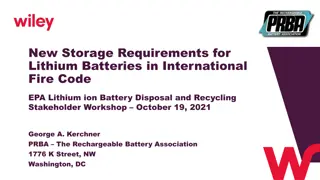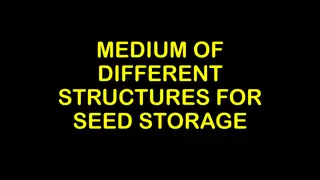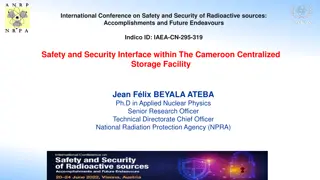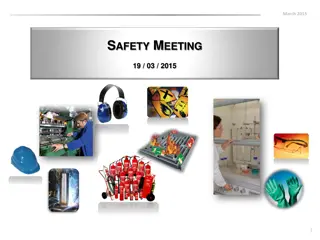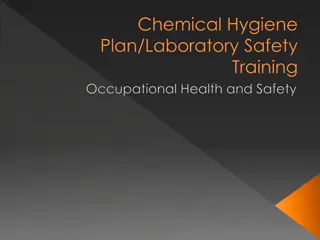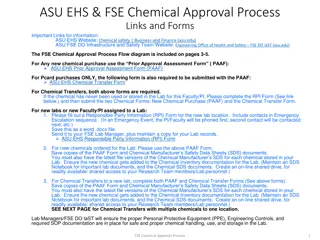Safety Guidelines for Chemical Storage and Organization
When storing chemicals, it's crucial to follow strict safety measures. This includes securely fixing storage shelves and cupboards to walls, using specialized cabinets for different types of chemicals, arranging chemicals by compatibility, and more. Cabinets should be clearly labeled, and chemicals stored according to hazard class. It's essential to prevent incompatible chemicals from being stored together, and follow specific storage requirements based on chemical categories. Refer to the Science Safety Handbook for detailed guidelines.
Download Presentation

Please find below an Image/Link to download the presentation.
The content on the website is provided AS IS for your information and personal use only. It may not be sold, licensed, or shared on other websites without obtaining consent from the author.If you encounter any issues during the download, it is possible that the publisher has removed the file from their server.
You are allowed to download the files provided on this website for personal or commercial use, subject to the condition that they are used lawfully. All files are the property of their respective owners.
The content on the website is provided AS IS for your information and personal use only. It may not be sold, licensed, or shared on other websites without obtaining consent from the author.
E N D
Presentation Transcript
Storage shelves and cupboards should be fixed rigidly to the walls and be equipped with restraining lips, wires, or other barriers. Storage may be handled with lockable cupboards, under-the-counter cabinets, or specially constructed (or purchased) cabinets, such as cabinets for acids, bases, and flammables.
Each cabinet chosen should be clearly and permanently (or at least semi-permanently) marked for its designated storage purpose. To the extent possible, chemicals should be kept in special storage containers used by the supplier (for both storage and shipping).
Chemicals are arranged first by compatibility and then alphabetically within each compatibility category. The common alphabetical system pattern must be abandoned in favor of one, for example, that separates the oxidizers from metals and separates the flammables, the corrosives, and the poisons.
Very basically Inorganics Corrosives Organics Flammables Poisons Ideally, liquids are stored in cabinets Specific to the hazard class Caution: Acids and bases are both corrosive
More Specifically Table 7.4 in the Science Safety Handbook Many chemical manufacturers and distributors have code systems to store chemicals by category This avoids incompatibility Refer to Appendix D of the Science Safety Handbook for California Public Schools List of Incompatible Chemicals
1. Metals Including red phosphorus All metals except mercury Flammable metals should be stored in their own flammable (liquid) cabinet Keep separate from oxidizers, halogens, organic compounds, and moisture
2. Oxidizers Nitrates, nitrites, permanganates, chlorates, perchlorates, peroxides Hydrogen peroxide 30% Except ammonium nitrate Keep Separate from metals, acids, organic materials, and ammonium nitrate Keep away from flammable liquids cabinet 20 feet One-hour fire wall
3. Ammonium Nitrate Store in isolation from all other chemicals Acids Powdered metals Sulfur Flammable liquids Oxidizers Finely divided organic combustible materials
4. Bases Strong Bases sodium hydroxide, potassium hydroxide Ammonium hydroxide Store in a dedicated corrosive-chemical storage cabinet
5. Acids Inorganic Except nitric acid Including regulated organic acids Store in a dedicated corrosive-chemical storage cabinet
6. Nitric Acid Must be stored separately from acetic acid Store either in an isolated compartment in the acid cabinet or in a special Styrofoam container Never use fuming nitric acid
7. Flammables Keep away from oxidizers 20 feet One-hour fire wall Store liquids in a dedicated flammable liquid storage cabinet Self-closing doors Heat- or flame-resistant paint
8. Poisons Mercury and mercury compounds Nicotine and other poisons Cyanides are no longer recommended for school programs Store in a lockable drawer remote from acids storage cabinet
9. Compressed gases Cylinders chained or strapped to prevent falling Caps on tight Keep flammable gases away from oxidizers 20 feet One-hour fire wall Keep oxidizing gases away from flammables 20 feet One-hour fire wall
Low-hazard Chemicals Store on open shelves with earthquake lips Dyes, indicators, stains Salts, sugars, agars Weak bases, oxides, carbonates, sulfates Non-corrosive organic acids, amino acids
Required by several regulations Utilize a spreadsheet that can be sorted including location, quantity, date of purchase, shelf life, and projected disposal date List all chemicals by their Shelf Name Example: 4. Bases Example: O2 (Organic shelf #2) Sort alphabetically within the shelf Allowing for ease of use and appropriate storage
Chemical Inventory updated of all chemicals,. Safety Data Sheets First aid instructions
Eye wash and Shower First Aid Kit Fire extinguisher and fire blanket Spill kit PPE Eye and face protection Gloves Compatibility Apron? Safety Data Sheets
The area is clean and orderly. A telephone is readily available. A current list of emergency telephone numbers is posted. Emergency procedures are up-to-date and posted.
There are no chemicals in storage that have been designated unsafe for school laboratory use (see Tables 7.1 and 7.2). Only chemicals that are used are stored (assuming chemicals not needed have already been disposed of). Chemicals on hand will be consumed within the next year (except for items with unlimited shelf life, such as iron filings). Chemicals are stored in compatible groups. Chemicals are properly labeled and stored in appropriate containers.
No chemicals are stored above eye level. No chemicals are stored on the floor. Shelves or cabinets are secured firmly to the walls. Earthquake lips or barriers are in place on storage shelves. Storage cabinets for corrosive chemicals (separate cabinets for acids and for bases) are on site and are used appropriately. A storage cabinet for flammables is on site and is used appropriately
Poisons are secured. The temperature of the storage area never exceeds 25 C (75 F). The storeroom door is self-closing and is locked. There is adequate ventilation (including a fume hood, if needed), and the area is isolated from the rest of the building. Room air is changed at least four times per hour. Compressed gas cylinders are secured upright to the wall, with caps in place. Flammable gases are separated from oxidizing gases by a one-hour fire wall or at least 25 feet (7.5 m). Nonreactive waste receptacles are made of plastic or crockery.




